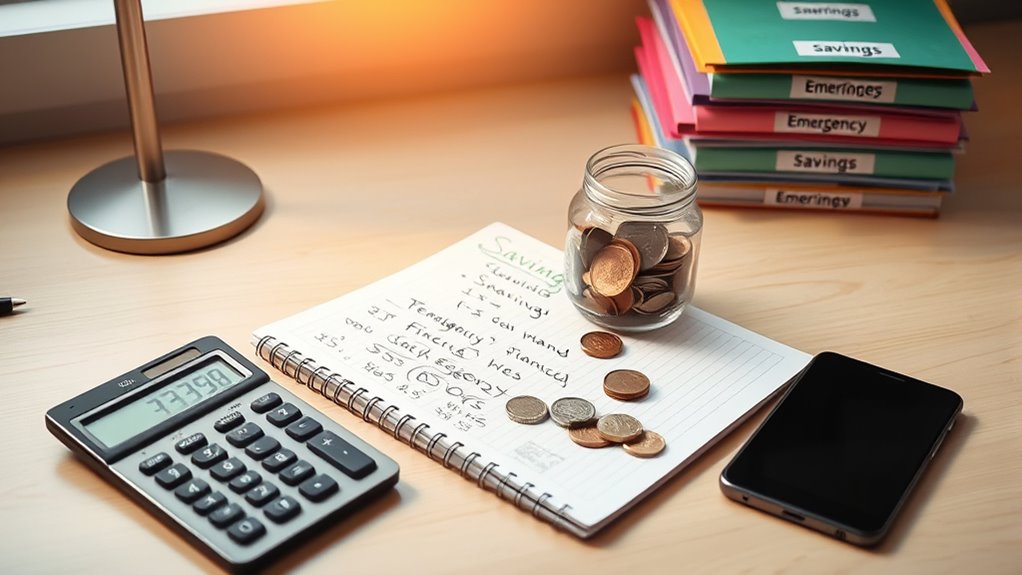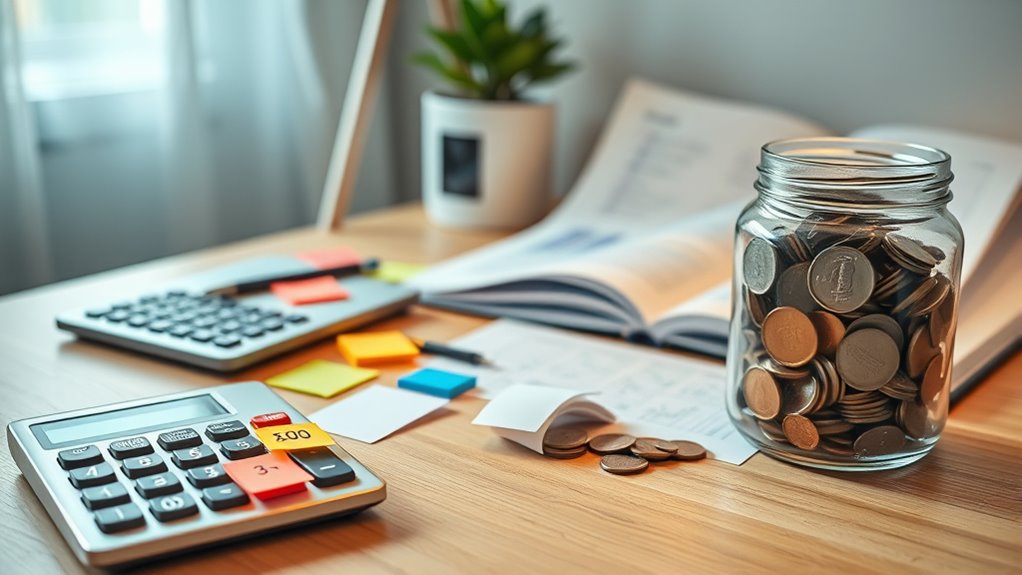To determine how much cash you need for an emergency fund, aim to save enough to cover three to six months of your living expenses, considering your personal circumstances and potential risks. Store this fund in accessible accounts like high-yield savings or money market accounts that offer safety and liquidity. As you accumulate savings, you can adjust your targets based on expenses or changes in your financial situation. Keep exploring to discover smarter strategies for building and managing your emergency fund.
Key Takeaways
- Aim to save 3-6 months of living expenses as your emergency fund target.
- Calculate your monthly expenses and multiply by the desired months to determine the total amount needed.
- Park the funds in high-yield savings accounts or money market accounts for liquidity and safety.
- Build your emergency fund gradually using automated transfers, starting with small milestones.
- Reassess your target regularly and adjust your savings as your expenses or income change.

Have you ever wondered how much you should set aside for an emergency fund? Knowing the right amount is vital because it acts as a financial safety net, helping you handle unexpected expenses without spiraling into debt. To determine this, you need to think about your personal circumstances, but a common guideline is to save enough to cover three to six months’ worth of living expenses. This isn’t just about hitting a savings milestone; it’s about ensuring your fund is sufficient to support your lifestyle during periods of income disruption, whether due to job loss, medical emergencies, or unforeseen expenses.
An emergency fund should cover three to six months of living expenses for financial security during unexpected events.
When planning your emergency fund, think of it as part of your overall investment strategies. Your approach to saving should balance risk and liquidity. For instance, while high-yield savings accounts are popular for their safety and easy access, you might also consider money market accounts or short-term certificates of deposit (CDs) for slightly higher returns. The goal is to keep your emergency fund in a place where it can be quickly accessed without penalties, but also where it can earn some interest to keep pace with inflation. Your choice of where to park this cash depends on your risk tolerance and how soon you might need the money.
Reaching savings milestones along the way helps keep you motivated. Start by setting small, manageable goals—saving $500 or $1,000—then gradually increase until you hit your target. Breaking it down makes the process less overwhelming and provides a clear sense of progress. Automating your savings can make this easier, ensuring you consistently contribute without having to think about it. As you build your fund, reassess periodically; life changes, and so should your savings goals. If your expenses increase or if you get a raise, update your target to match your new financial situation.
The key is to be intentional with your savings plan. Set aside a specific portion of your income each month and stick with it. Your emergency fund isn’t just about reaching a number; it’s about creating a financial cushion that provides peace of mind. As you hit each milestone, celebrate your progress, but keep your eyes on the bigger picture—having enough to weather any storm. Remember, the right amount and the right place to park your money will give you confidence, knowing that no matter what life throws your way, you’re prepared.
Frequently Asked Questions
How Often Should I Review and Update My Emergency Fund?
You should review and update your emergency fund at least once a year or after major life changes, like a new job or move. This helps you stay aligned with your current expenses and investment strategies. Recognizing emergency fund psychology is key—knowing it provides security boosts confidence. Regularly checking guarantees your fund remains sufficient, giving you peace of mind and better preparedness for unexpected events.
Can I Combine Multiple Savings Accounts for My Emergency Fund?
Imagine your emergency fund as a fortress; combining multiple savings account options can strengthen it. You can certainly merge accounts through account consolidation strategies, making management easier and potentially earning better interest. Just guarantee each account is accessible, secure, and offers favorable terms. By consolidating, you streamline your savings, reduce confusion, and keep your fortress intact, ready to protect you in times of need.
What Are the Tax Implications of My Emergency Fund Investments?
When considering your emergency fund investments, you should think about tax implications. Tax-advantaged accounts like Roth IRAs or HSAs can help your money grow tax-free, giving you more leverage in emergencies. On the other hand, taxable investment options might generate capital gains or dividends, which could be taxed. It’s smart to balance your fund across these options to minimize taxes and maximize accessibility when you need it most.
Should I Include Potential Future Expenses in My Emergency Fund Calculations?
Imagine you’re packing a bag for a journey—wouldn’t you include some extra clothes for unforeseen weather? Similarly, you should incorporate potential future expenses into your emergency fund calculations. Planning for unexpected costs guarantees you’re prepared for life’s surprises, like medical bills or car repairs. By accounting for these, you create a financial safety net that truly covers all bases, giving you peace of mind when life throws curveballs.
How Do I Prioritize Funding My Emergency Fund Over Other Financial Goals?
You should prioritize funding your emergency fund first by applying clear prioritization strategies. Recognize that delaying other financial goals can lead to opportunity costs, so balance your savings wisely. Focus on building a sufficient safety net to cover unexpected expenses, then gradually work toward your other goals. This approach helps you manage risks effectively while still progressing financially, ensuring you’re protected without sacrificing long-term plans.
Conclusion
So, there you have it. With a little math and a dash of common sense, you can stash away enough cash to weather life’s inevitable storms—because who doesn’t love the thrill of a financial safety net? Just remember, whether you park it in a high-yield account or under your mattress, the real goal is peace of mind. Or at least, the illusion of control—because in the end, isn’t that what really counts?









